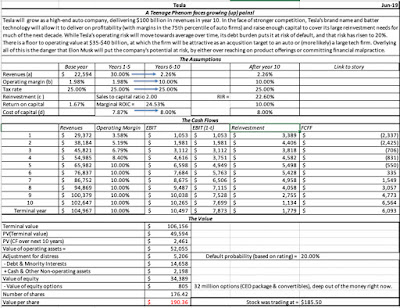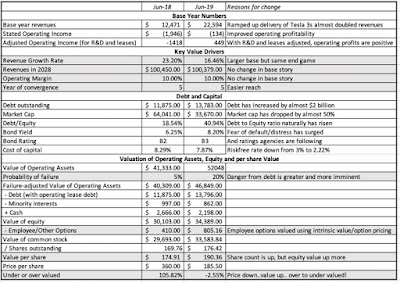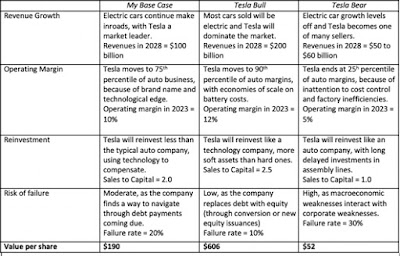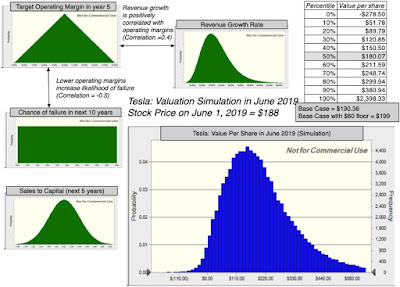
Copyright: wolandmaster / 123RF Stock Photo
- Revenue Surge: In the drama around production targets and logistical misses, it is easy to lose sight of the fact that the Tesla 3 has caused the company to almost double revenues over the course of the last year, while easily winning the race for best selling electric car in the world.
- Improving Profitability: While Musk’s tweets about Tesla turning earnings positive may have been premature, the company has moved down the pathway to profitability, reducing operating losses and with R&D capitalized, perhaps even turning the corner on operating profitability.
Follow Tesla Inc. (NASDAQ:TSLA)
Follow Tesla Inc. (NASDAQ:TSLA)
- Debt load and Distress: When Tesla chose to add to its debt burden by borrowing $5 billion in 2017, I argued that there was no good reason for Tesla to borrow money, since money losing companies gain no tax benefits and debt put growth potential at risk. Tesla has since added to that debt, using the false logic that it needed to borrow money to fund its growth; a much better option would have been to raise equity, the dilution bogeyman notwithstanding. In June 2019, that debt, now close to $14 billion, is revealing its dark side, as a bond price plunge and ratings downgrades threaten to put Tesla’s growth story at risk.
- Reinvestment Lags: Growth requires reinvestment, and especially so for automobile companies, where assembly lines and logistical infrastructure need to be put in place for cars to be delivered to customers. It is both frustrating and puzzling that Tesla, a company with a loyal customer base that is willing to wait, has been unwilling to make the investments that it needs to meet the demand. Instead, the company seems to lurch from one production crisis to another one (remember the tents that had to be put up to reach the 5,000 cars/week target) while its CEO muddies the water further by arguing that the company is not just earnings positive but cash flow positive. At the moment, the Fremont plant remains Tesla’s major production facility, and while a plant in China is supposedly set for production late in 2019, the US/China trade war and Tesla’s own tangled history on operating delays leads to skepticism.
- SEC Oversight: If there has been a recurring story over the past year, it has to do with the aftermath of Elon Musk’s “funding secured” tweet, which led to a SEC investigation and a threat of sanctions on the company. While the company came to a settlement wit the SEC, that settlement requires restraint on the part of Musk on future disclosures to the market (especially in the form on tweets), and restrain is not a Musk strong point.
- Autonomous Cars: In April 2019, Musk unveiled a plan to roll out autonomous taxis, with Tesla owners being allowed to add to the network, in the near future, with the promise that Tesla’s technology on auto driving was well ahead of the competition. There is a debate worth having about autonomous cars and how they will change the ride sharing business, but it is almost certain that this will not happen smoothly or soon.
- The Rest: This being Tesla, there were the weekly distractions as Musk muddied the waters with talk of electric leaf blowers and insurance products.
 |
| Download spreadsheet |
 |
| Download ARK pricing from Github |
- This is a pricing, not a valuation: I know that this will strike some as nitpicking but what ARK has produced is a forward pricing for Tesla, not a valuation. An intrinsic valuation requires forecasting cash flows over time, after taxes and reinvestment, and then discounting those cash flows back at a rate that reflects the risk in the investment. A pricing usually involves picking a metric (revenues, earnings, EBITDA), picking a forecast year for the metric and applying a multiple based upon what other companies in the peer group trade at. ARK’s basic model forecasts revenues, earnings and other metrics in 2023, and applies a multiple to estimated EBITDAR&D in 2023, making it a forward pricing.
- The ARK bear is bullish: The ARK bear case requires that Tesla will sell 1.7 million cars in 2023, at an average price of $50,000/car and generate an operating margin of 6.1% on those revenues. Each of these assumptions is plausible, and the combination is possible, though to call a seven fold increase in revenues over five years, with a concurrent improvement to industry average profitability, a bear case seems to be stretching the definition of bear.
- The weakest link: The model’s weakest link is on cash flows, since to sell 1.7 million cars, you have to make them first, and Tesla’s production capacity, even if you count the China plant as functional and about the same capacity as the Fremont plant, brings you only about half way to the goal. It will be magical, if adding another $3.7 billion to net PP&E (as ARK seems to be assuming) and $1.2 billion to working capital will allow you to increase revenues by $63.5 billion, but it gets even more stretched, when you assume that Tesla also pays off $14 billion in debt (as ARK seems to) over the five years. In sum, the bear case will require at the very least $25 to $30 billion in cash flows, even with ARK’s own assumptions, over the next five years, and since the operating cash flows at the company are still a trickle, this will require equity issuances in massive proportions fairly soon. ARK does allow for an equity capital raise of $10.6 billion which strikes me as too little to fill the gap, but in the absence of a balance sheet or statements of cash flows, I may be missing something (and it has to be very big).
- Share count issue: Even for the equity capital raise of $10.6 billion, ARK reduces the impact on share count by assuming a stock price of $360/share (market cap will be $70 billion) at the time of the raise. Since this capital will have to be raised soon, there is an element of wishful thinking here, i.e., that stock prices will double in short order and the capital raise will follow. In addition, if stock prices do climb, as ARK assumes, there will there is an overhang of 20 million options that have been granted to Musk by the board of directors that will become actual shares. In short, for the ARK bear case to unfold, the share count will have to double over the next five years.
- There is a time value question: Applying a multiple to EBITDAR&D in 2023 gives you a value in 2023, and to make it comparable to today’s stock price, you will have to discount it back to today, at a risk adjusted rate. In fact, if you bring in the probability of failure embedded in Tesla bonds, there will an additional discounting on value.
Disclosure: None







